Turtle Hill is home to a porcupine that I have named Po. Most of the animals that we share this property with are only glancingly visible, but this summer Po chose to spend much of her time near the house. She enjoyed grazing on clover in the backyard and didn’t care a whit that a little dog was on the other side of the fence.
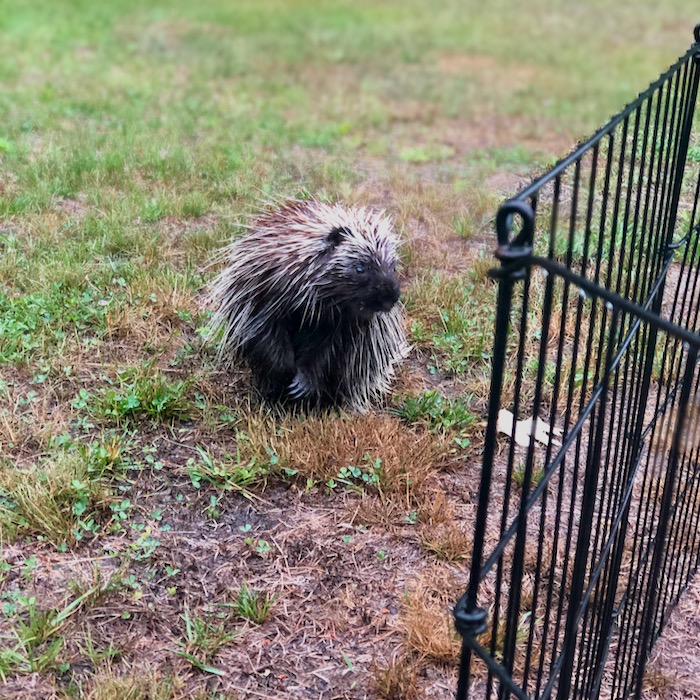
I know that Po is female because a few times we saw her porcupette in tow (isn’t that the best term for a baby animal?) Porcupines are solitary creatures, and they don’t even spend a lot of time with their offspring. She nurses only once a day. A mamma will park her porcupette at the base of a tree while foraging for hours. As the baby matures, they go out at night together and she’ll teach her offspring what to eat and how to get by. By late summer they’re going their separate ways. So, mostly, we saw Po.
There is a field at the front of the house.
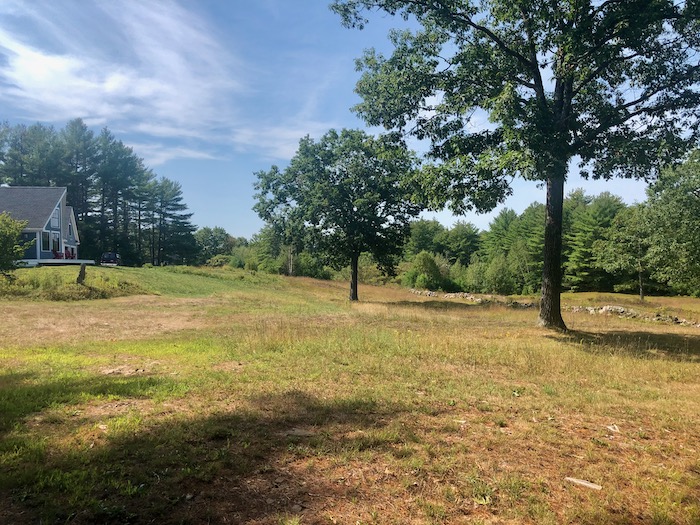
There is a line of 4 oak trees.
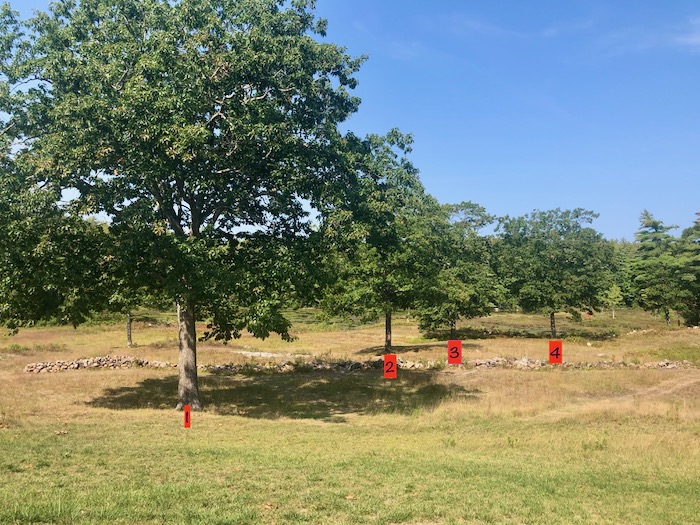
During the heat of this very hot summer, Po chose to spend her days in oak tree #1, which meant that we could watch her from our deck. I think that the breezes kept her comfortable.
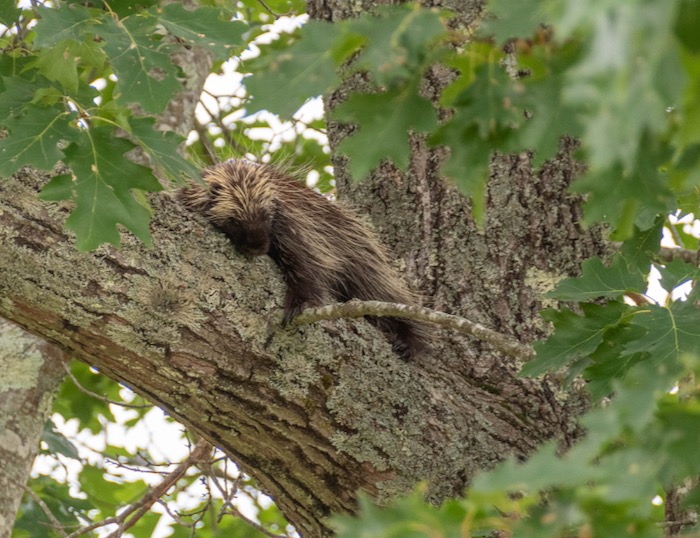
Of course, the fact that there were snacks at the ready through the day was part of the appeal of this location!
By the end of August Po had moved on from oak tree #1. Occasionally we’d see her at night (porcupines are mostly nocturnal) foraging in the backyard, and we captured images of her on the wildlife cam that we have set up in the woods. I particularly like this screen shot of her plodding along with a leaf stuck on a quill.
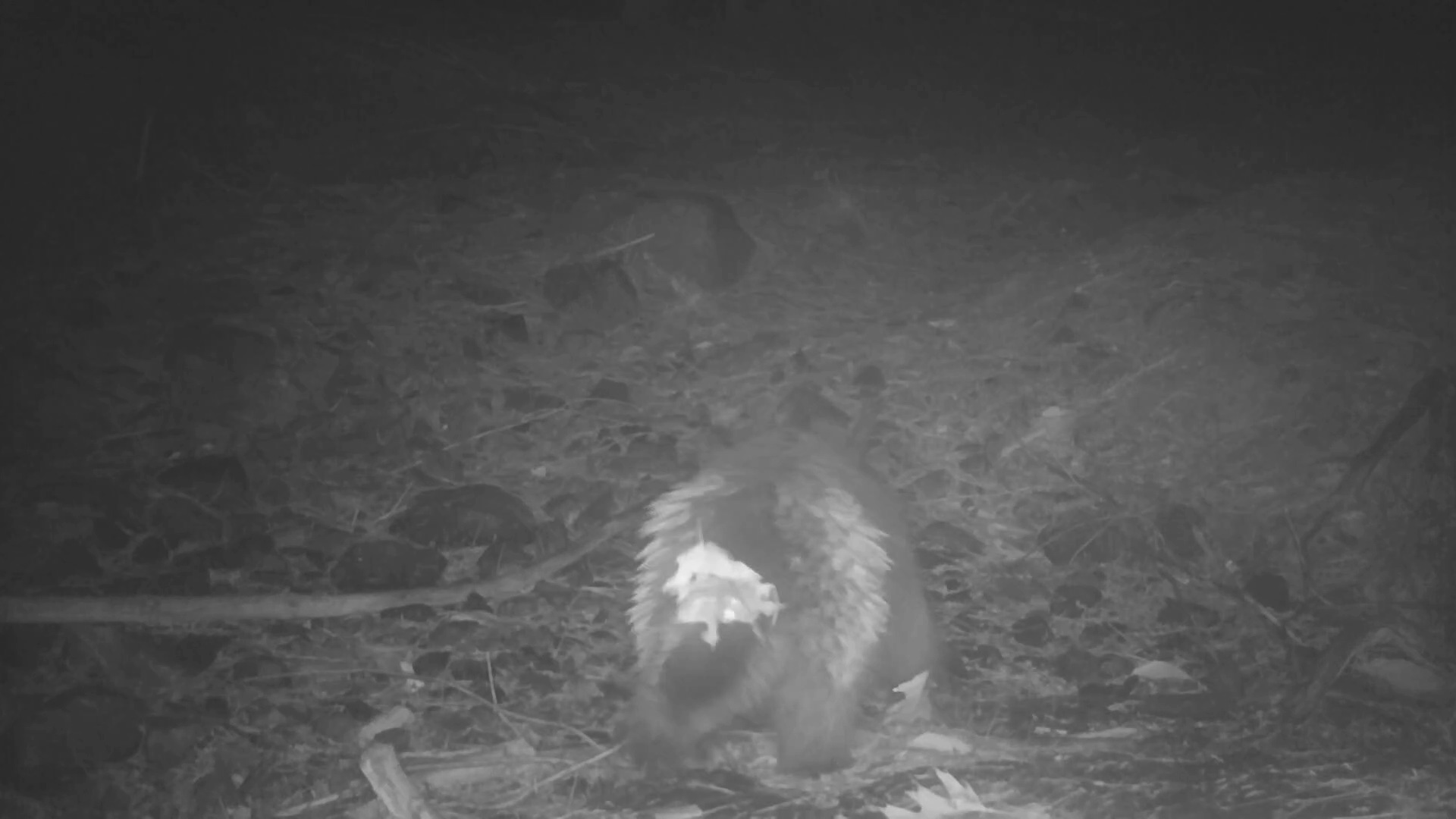
Recently Po has returned to the oak trees. The leaves are no longer tasty, but the young acorns, still high up in the branches, are. She eats the acorn meats cleanly out of their caps.
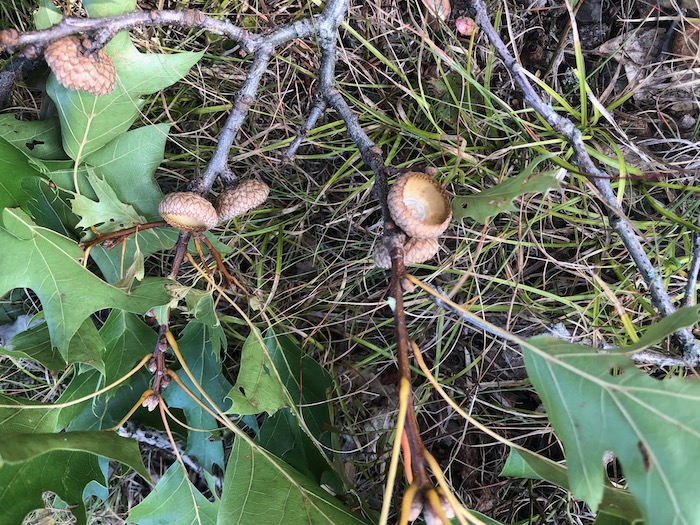
I haven’t watched her do this, but I know that she’s there because of the nip twigs. (Nip twig is an official term. Almost as good as porcupette!) The base of oak tree #4 is littered with nip twigs.
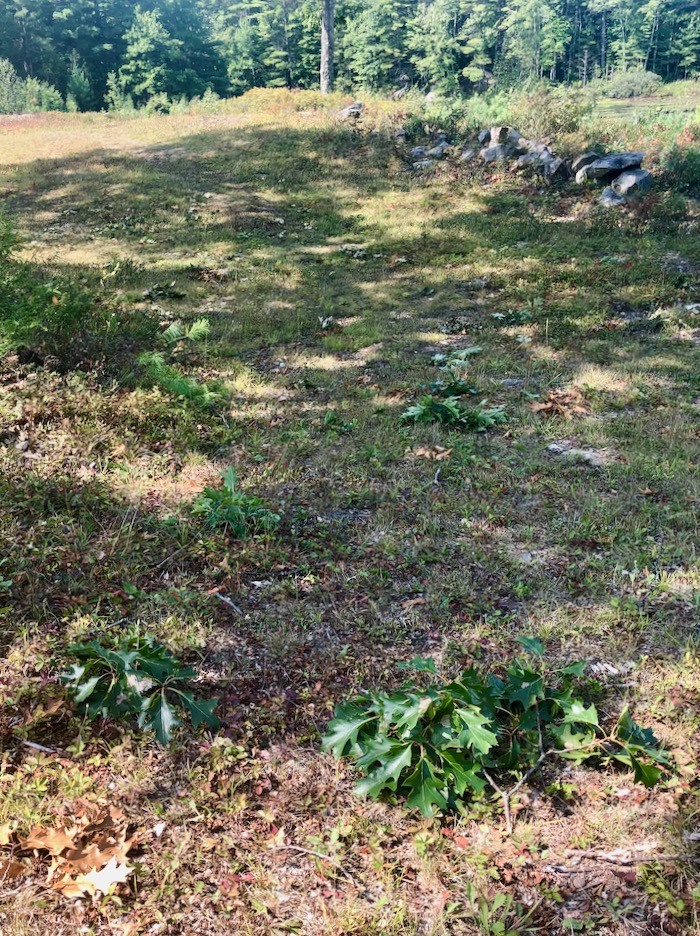
You know that it wasn’t the wind that broke the branches off because you can see the angled chew marks.
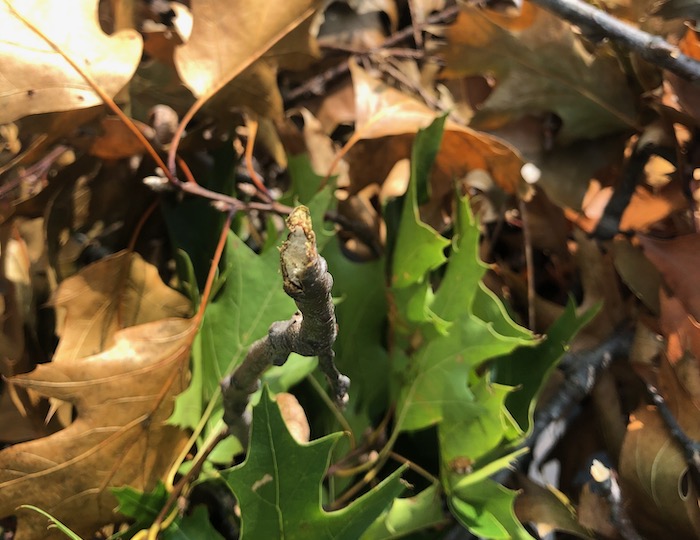
I’ve looked and looked, but Po is not sleeping in the tree during the day. I guess that now that the weather is cooler she doesn’t need to splay herself high up on a limb.
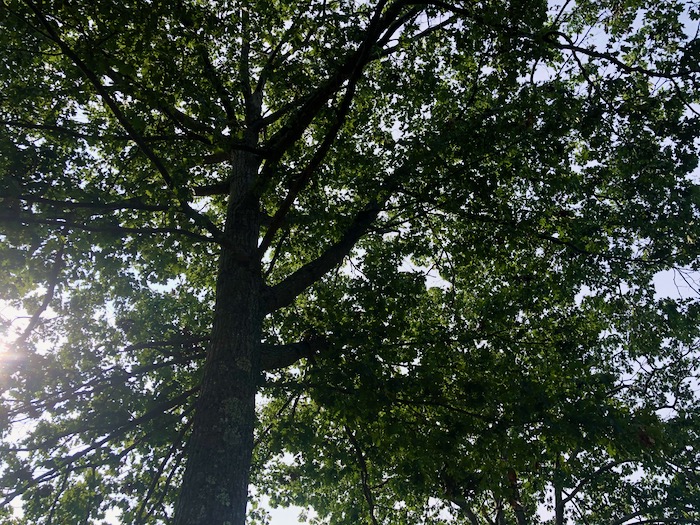
Once a year I mow the field to keep saplings and invasive roses from taking over. I’ll do that after the first frost. Before then, I have to clear up Po’s mess. My little electric mower can’t handle nip twigs. Especially not the quantity and size that Po has been throwing down! So far, I’ve filled the dump cart up twice.
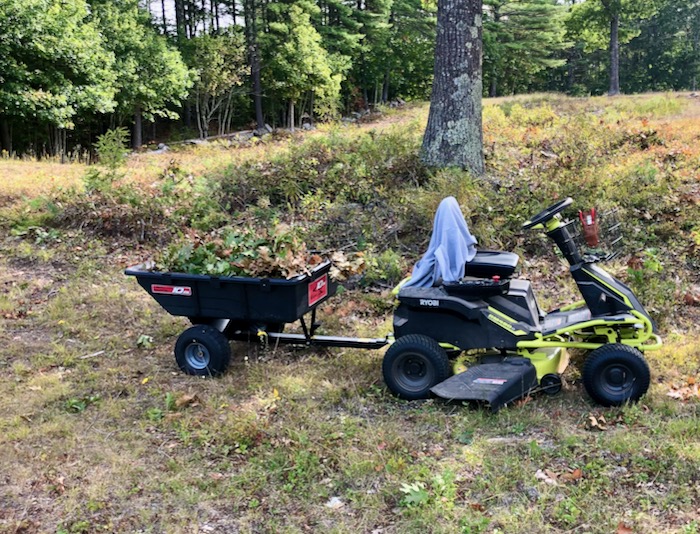
Who knew that when I left my garden and chickens that I’d still have to clean up after the resident animals?
Note: For more on the North American porcupine, start with this page from the Animal Diversity Web. For THE book on porcupines, read The North American Porcupine by Roze.


I got a thrill when, years ago, my Aussie alerted me to a porcupine lumbering down the opposite side of our perimeter fence. It’s the only time I’ve seen one out here and sadly, the thickly wooded lot it was in has since been cleared and built on.
Good thing she alerted but didn’t investigate!
Oh! I just loved this story! Where do you think she hangs out now during the day?
Last winter she spent time in a hollow tree in the woods. We know because there was a huge pile of scat at the bottom of it.
Thank you for the wonderful insight into the fantastic wildlife you have at Turtle Hill. Love reading all the blogs. With eagles, coyotes and wolves i understand why it would be difficult to keep chickens and why Scooter needs his safety fence, i have seen a buzzard take a chicken from a field where they were free ranging. As always stay safe all of you 🙂
No wolves! 🙂 But I could add a few other predators to the list, like fisher cat.
This past summer we found ‘nip twigs’ under our massive oak tree and constantly wondered what was causing the messy situation. Now we know…a porcupine! How delightful to learn that the adorable culprit was perhaps snoozing above our heads during those hot summer days. Thank you Terry!
Porcupines have a home territory and favorite trees, so perhaps next year you’ll see her. They can also live a decade, so hopefully you’ll get to know this one.
That is so special to be able to share in the life of a porcupine. Especially that their babies are called porcupettes. How cute.
They are especially endearing animals. They grumble and mumble and talk to themselves, too.
I’m still giggling over ‘Porcupette’! What a delicate, feminine name for such an ungainly creature. Although, a zookeeper I saw on TV once said they are quite smart and even affectionate.
(“Porcupette!” :::::snort:::::)
At the Center For Wildlife, a local rehab org near here, they have a porcupine, Henry, who is very personable and adored by all.
“…and the porcupine talks to himself” – my favorite line from the wonderful Bill Staines song “All God’s Critters Got A Place In The Choir”. You can find Bill telling the story of how that line came to be (starting at about 1:55): by googling Bill Staines – A Place in the Choir, 1-17-2009.
Porcupines are awesome!
Many years ago I saw Bill Staines in concert. He told the story about how he came up with that line. He was camping and heard what he thought was an old man talking and stumbling into his campsite. It was a porcupine. Funny on the recording. Funny in person 🙂
I really enjoyed reading about Po!! I have never seen one in the wild, so it was especially interesting. I always love your blog posts. They are a bright spot in these crazy days.
I’ll post more about Po. We’re fortunate to see her, and evidence of her, almost daily.